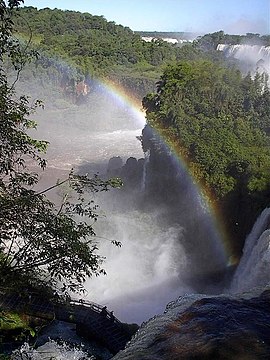Foz do Iguaçu
| Foz do Iguaçu | ||
|---|---|---|
|
Coordinates: 25 ° 33 ′ S , 54 ° 35 ′ W Foz do Iguaçu on the map of Paraná
|
||
| Basic data | ||
| Country | Brazil | |
| State | Paraná | |
| City foundation | June 10, 1914 | |
| Residents | 256,088 (IBGE 2010) | |
| City insignia | ||
| Detailed data | ||
| surface | 617.7 | |
| Population density | 414.58 inhabitants / km 2 | |
| height | 200 m | |
| Waters | Iguaçu , Paraná | |
| Time zone | UTC −3 | |
| City Presidency |
City Prefect: Francisco Lacerda Brasileiro ( PSD ) (2017–2020) |
|
| Website | ||
| Iguaçu Falls near Foz do Iguaçu | ||
Foz do Iguaçu (Portuguese: [ ˈfɔs du iɡwaˈsu ]; in Spanish Foz de Iguazú; officially Município de Foz do Iguaçu ) is a city in Brazil in the southwest of the state of Paraná . The name is a combination of the Indian Iguaçu ("big water") and the Portuguese foz ("mouth"), which means "mouth of the big water".
geography
Foz do Iguaçu is located at the mouth of the Iguaçu River in the Paraná River, right on the border with the Spanish-speaking countries Paraguay and Argentina . The city is connected to Ciudad del Este in Paraguay via the Puente de la Amistad (Spanish), also Ponte da Amizade (port.) ("Bridge of Friendship") . Puerto Iguazú is on the Argentine side of the Iguaçu and can be reached via the Ponte Tancredo Neves .
The Iguaçu Falls are located about 25 kilometers above the confluence of the Iguaçu and Paraná rivers . Due to its proximity to the waterfalls, Foz do Iguaçu is a popular tourist destination. With the construction of the Itaipú dam on Paraná, the population of Foz do Iguaçu increased and according to the 2010 census it is 256,088 inhabitants. For 2012, the IBGE estimated a slightly declining population of approx. 255,718 estimated. The inhabitants of the city are called iguaçuenses.
history
In 1910, Vila Iguassu was established as a district of the city of Guarapuava , then on March 14, 1914, by ordinance Lei 1383, it was granted city rights as Município de Vila Iguaçu , taking into account the Brazilian spelling reform introduced in 1911. The first city prefect was Jorge Schimmelpfeng, and the first city council was established in 1914. The city was given its current name Foz do Iguaçu in 1918.
The city is the seat of the diocese of Foz do Iguaçu .
sons and daughters of the town
- Tatiana Pinto (* 1994), Portuguese soccer player
Other personalities
- Mosè Giacomo Bertoni (born June 15, 1857 in Lottigna , † September 19, 1929 in Foz do Iguaçu), anarchist , botanist, founded the National Agricultural School in Asunción
See also
Web links
- Foz do Iguaçu Prefecture website (Portuguese)
- Histórico, Foz do Iguaçu , short version of the city's history, IBGE. Retrieved July 25, 2013 (Portuguese)
Individual evidence
- ↑ a b Instituto Brasileiro de Geografia e Estatística (IBGE): Sinopse do Censo Demográfico 2010: Foz do Iguaçu. (No longer available online.) Formerly in the original ; Retrieved July 25, 2013 (Portuguese). ( Page no longer available , search in web archives ) Info: The link was automatically marked as defective. Please check the link according to the instructions and then remove this notice.
- ↑ Instituto Brasileiro de Geografia e Estatística (IBGE): Estimativa Populacional 2012. (No longer available online.) July 1, 2012, formerly in the original ; Retrieved July 25, 2013 . ( Page no longer available , search in web archives ) Info: The link was automatically marked as defective. Please check the link according to the instructions and then remove this notice.
- ^ Danilo Baratti: Mosè Giacomo Bertoni. In: Historical Lexicon of Switzerland . May 18, 2004 , accessed February 9, 2020 .
- ^ Mosè Giacomo Bertoni (Italian) on ti.ch/can/oltreconfiniti



